JANUARY 14 2025 - 15 MIN READ
How to Find a Meeting Time That Works for Everyone in 2025
Table of Contents
Have you ever struggled with finding a meeting time that works for everyone? Want to learn how to find a meeting time that works for everyone?
You're not alone, as event scheduling across different time zones or busy calendars can be a frustrating and time-consuming task.
Coordinating with remote teams or aligning the schedules of multiple participants can feel like a never-ending back-and-forth. With the right tools, strategies, and planning, you can find a meeting time that works for everyone and reduces stress.
Knowing how to find a meeting time that works for everyone is crucial for maintaining productivity and collaboration. Whether you’re scheduling a Google Meet, planning a client consultation, or a family reunion, the right timing can make all the difference.
This post will guide you through practical tips and tools that can help you navigate the complexities of meeting scheduling in 2025. We’ll show you how to find a meeting time that works for everyone effortlessly and efficiently.
Read on to:
- Understand why scheduling matters
- Recognize the challenges of how to find a meeting time that works for everyone
- Discover tips on how to find a meeting time that works for everyone
- Explore the best scheduling tools of 2025
Let’s get into the details!
Why is it Important to Find a Meeting Time That Works for Everyone?
With hybrid work models and global teams becoming the norm in 2025, the complexity of scheduling meetings has increased.
Poor meeting scheduling often results in wasted time, disengaged participants, and missed opportunities. Finding a meeting time that works for everyone is more than just about convenience—it’s the key to productive, stress-free collaboration.
When you understand how to find a meeting time that works for everyone, you set the stage for effective communication and smooth workflows.
Here’s why scheduling matters:
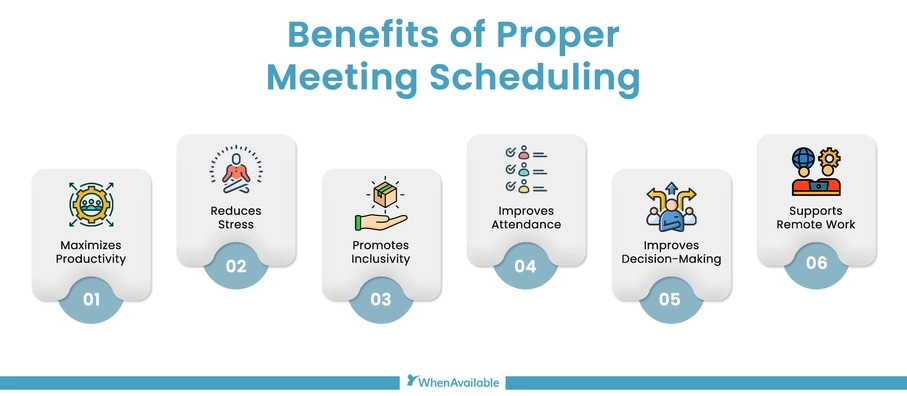
- Maximizes Productivity:Choosing the right time for internal meetings ensures that all participants are focused and ready to engage. When people are not scrambling to attend or deal with conflicts, they are more productive and contribute meaningfully.
- Reduces Stress: Scheduling conflicts can lead to frustration and delays. By learning how to find a meeting time that works for everyone, you can reduce the stress of rescheduling and last-minute adjustments.
- Promotes Inclusivity: A well-planned meeting accommodates everyone, considering varying working hours or remote work arrangements. This inclusivity fosters better teamwork and cooperation.
- Improves Attendance: When you find a meeting time that works for everyone, attendance improves. Fewer people miss meetings, and participants are more prepared and engaged.
- Improves Decision-Making: Effective scheduling involves finding meeting times that accommodate all key stakeholders and attendees. When everyone is present and engaged, decisions are more informed, leading to better outcomes.
- Supports Remote and Hybrid Work: Remote and hybrid work are the norm today. To enhance the meeting experience, it's essential to schedule a meeting during available time slots that accommodate work-from-home policies, ensuring seamless collaboration and inclusivity.
Understanding how to find a meeting time that works for everyone improves workflow, making meetings more efficient and keeping your team aligned and engaged.
Impact of Poor Scheduling
When poor meeting scheduling becomes a recurring issue, it doesn’t just affect individual productivity—it can have a long-term impact on the overall success of your business.
If you don’t learn how to find a meeting time that works for everyone, you may face the following issues.
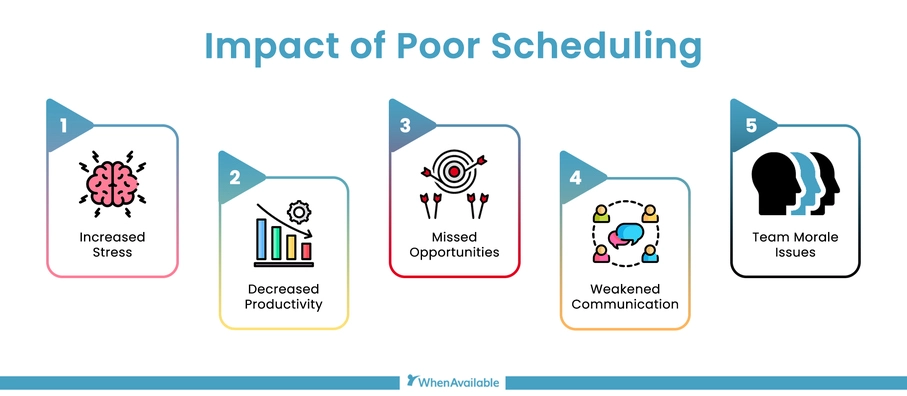
- Increased Stress: Constantly juggling schedules and implementing last-minute changes can negatively impact the meeting experience, leading to frustration and stress among team members. The more time spent rescheduling, the less time your team has to focus on their actual work.
- Decreased Productivity: Poor scheduling can lead to wasted time. If meetings are held at inconvenient times or are repeatedly rescheduled, it disrupts employees’ workflow, reducing their overall productivity and engagement.
- Missed Opportunities: When meetings are scheduled inefficiently, critical discussions can be delayed or missed entirely. This results in missed opportunities for collaboration, decision-making, and addressing time-sensitive issues. Using a scheduling app like Google Calendar or a free meeting scheduler can help avoid these pitfalls.
- Weakened Communication: Poorly scheduled internal meetings can lead to poor communication. If key stakeholders miss meetings or are distracted due to scheduling conflicts, misunderstandings arise, reducing the quality of collaboration. Meeting polls or round-robin meetings can improve attendance and participation.
- Team Morale Issues: Constant scheduling conflicts can negatively affect team morale. When people feel like their time isn’t valued, they may become disengaged, which can ultimately lead to higher turnover rates. A preferred meeting time that works for everyone can help resolve these issues and boost team morale.
Understanding the Challenges of How to Find a Meeting Time That Works for Everyone
Before discussing solutions, it’s crucial to recognize key challenges small business owners face when coordinating meetings.
Identifying these obstacles allows you to address them more effectively, improve the scheduling experience, save time, and ultimately find a meeting time that works for everyone.
When you learn how to find a meeting time that works for everyone, you’ll face the following challenges.
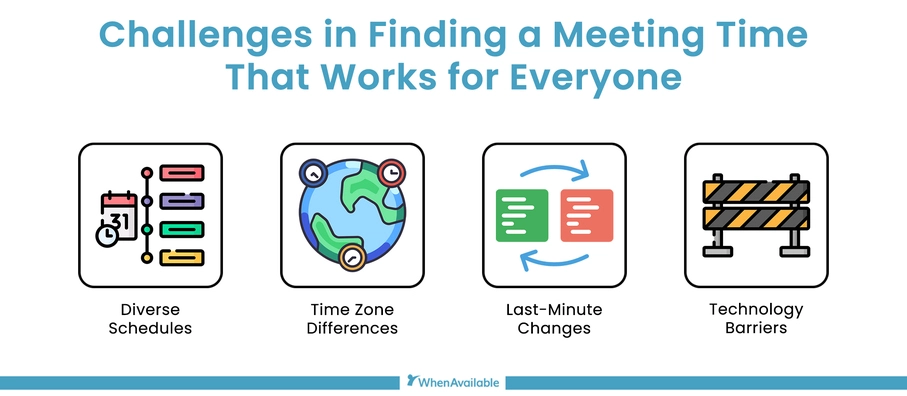
Diverse Schedules
One of the most time-consuming aspects of how to find a meeting time that works for everyone is fitting diverse schedules.
Team members may have different work hours, personal commitments, or obligations, making it difficult to find a preferred meeting time. This often leads to frustration and wasted time trying to agree on a slot that works for everyone.
Time Zone Differences
For global businesses with teams across different regions, time zone differences are a significant challenge in finding a meeting time that works for everyone.
Coordinating across multiple time zones complicates scheduling, often leading to missed collaboration opportunities.
Last-Minute Changes
Last-minute changes in availability can disrupt even the best-laid plans, especially when trying to find a meeting time that works for everyone.
Sudden emergencies or priority shifts leave team members scrambling to reschedule, which is both time-consuming and frustrating. These changes can lead to delays and force teams to spend more time reorganizing their schedules.
Technology Barriers
Not all team members are familiar with digital scheduling tools, which can hinder the process of finding a meeting time that works for everyone.
Technology barriers, such as difficulties with scheduling software or poor internet connectivity, can delay the meeting process or even prevent participants from joining. This complicates the scheduling experience, leading to inefficiency.
8 Tips on How to Find a Meeting Time That Works for Everyone
Let’s face it, coordinating meetings can feel like solving a puzzle where the pieces don’t always fit. But with a few smart tips, you can find a meeting time that respects everyone’s schedule and keeps your team on track.
Here are eight tips on how to find a meeting time that works for everyone.
1. Utilize Scheduling Tools
One of the most effective tips on how to find a meeting time that works for everyone is by using scheduling tools. Using the right tools simplifies the process of coordinating with participants and eliminates the need for endless back-and-forth emails.
Instead of playing calendar Tetris, scheduling tools allow you to easily find a meeting time for participants. This allows you to identify the best times that work for everyone, without the usual confusion or delays.
WhenAvailable, for example, is a group scheduling tool that can help you find a meeting time that works for everyone. You can also use it to send scheduling links that allow people to vote for dates and time slots that work for them.
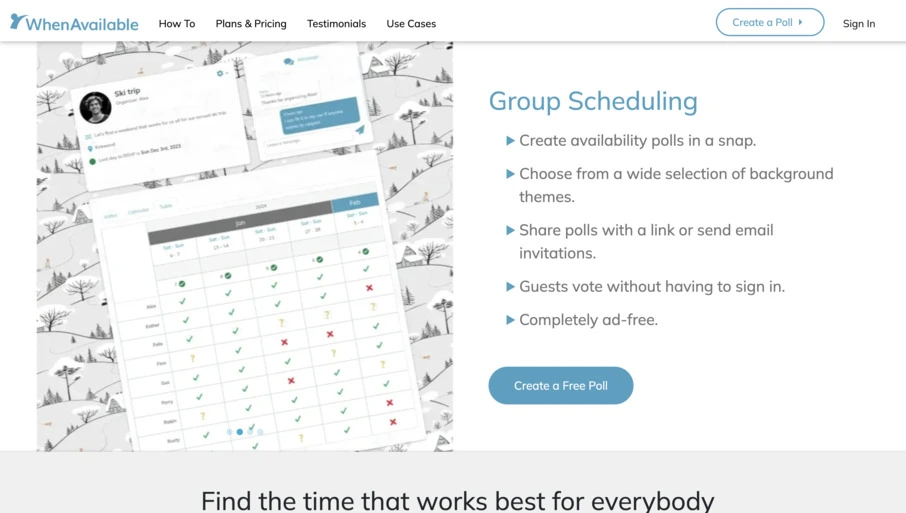
Image via WhenAvailable
Here are some other use cases for WhenAvailable:
- Board Meetings: Simplify the process of aligning the schedules of busy executives and stakeholders for board meetings, ensuring important decisions get made on time.
-
Book Clubs: Keep your group engaged by finding the perfect time to meet and discuss
your latest read, even with members in different time zones.
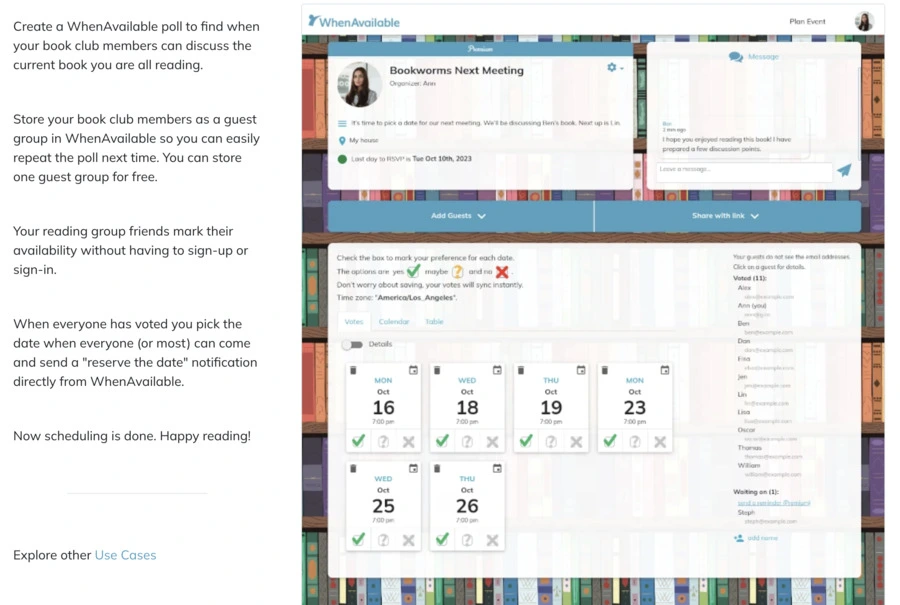
Image via WhenAvailable
- Weekend Activities: Plan outings like weekend barbecues, or family events by coordinating availability in just a few clicks.
However, you can choose any tool, per your requirements.
Here are some things you should look for in scheduling tools:
- Time-Saving Features: Choose tools like a meeting scheduler that help you find a meeting time that works for everyone quickly and efficiently, giving you more time to focus on your work.
- User-Friendly Interfaces: Look for scheduling tools with intuitive interfaces that are easy to navigate, regardless of technical expertise. This makes it simple for everyone on your team to submit their availability and confirm a meeting time.
- Integration Options: Opt for scheduling tools that integrate seamlessly with popular calendars. Once a time is selected, the tool automatically updates everyone’s calendar, eliminating the need for manual syncing or rescheduling.
By using scheduling tools, you eliminate the chaos of trying to find a meeting time that works for everyone. Instead, you create a more efficient and productive way to manage your meetings.
Pro Tip: Automating your scheduling with the right tools helps reduce errors and ensures your meetings run smoothly without any confusion.
2. Use Shared Calendars
Scheduling a meeting can feel like assembling a jigsaw puzzle with multiple missing pieces that need to fit perfectly. Shared calendars help you quickly find where all the pieces fit, making it easier to find a meeting time that works for everyone.
Tools like Google Calendar or Microsoft Outlook can take the guesswork out of scheduling. These tools allow you to view everyone's availability in one place, making it easier to find a meeting time that avoids clashes.
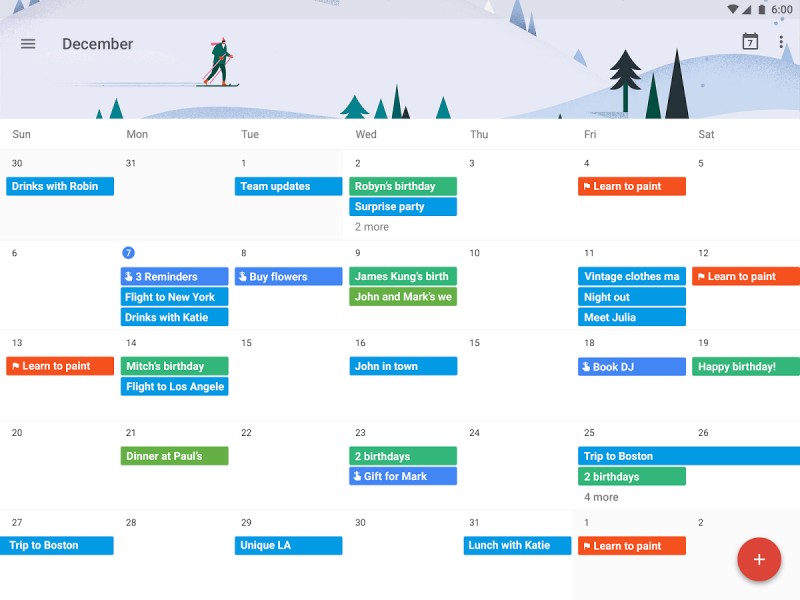
Image via Google Calendar
By syncing calendars, you can instantly find open slots and reduce the back-and-forth emails that typically slow down the process.
Pro Tip: Take it up a notch by using color coding to categorize your availability. Mark your focus time, breaks, and meetings in different colors to instantly communicate when you’re free or unavailable.
3. Offer Only a Few Options
When it comes to scheduling meetings, offering too many time slots can create confusion and unnecessary delays. Rather than overwhelming your team with an endless list of options, narrow it down to a handful of preferred meeting times that work within everyone’s schedule.
This makes it much easier to lock in a time quickly. The fewer choices you give, the quicker your team can make a decision and get back to their work.
Pro Tip: For teams working across different time zones, focus on finding overlapping working hours. This reduces the chances of scheduling at inconvenient times, making sure everyone can attend without compromising their schedule.
4. Set Recurring Meetings to Save Time
Setting up recurring meetings for internal sessions or weekly check-ins means no more constant back-and-forth. You lock in a time once, and it's set for the long haul.
Here's an image showing recurring meetings scheduled at the same time every Monday to Friday:
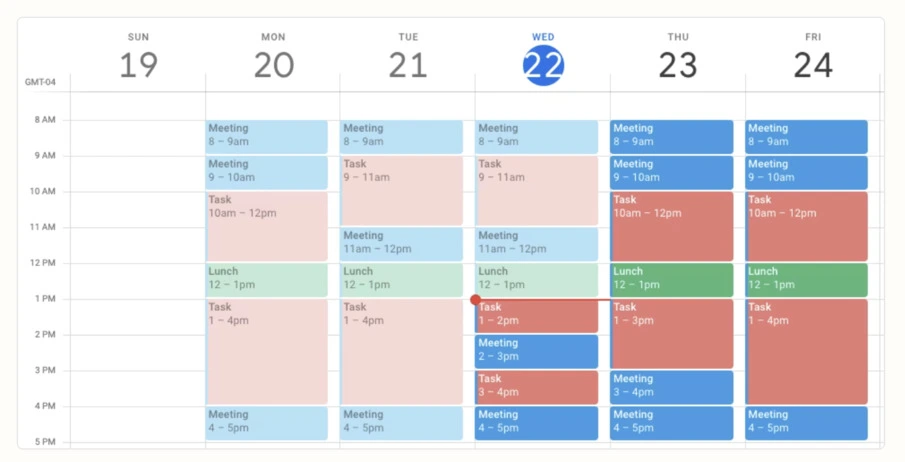
Image via Zapier
Instead of scrambling to find availability each week, your meetings are already scheduled, saving time and reducing stress.
By creating a predictable schedule, you help your team stay on track and avoid last-minute changes that disrupt productivity.
Additionally, when everyone knows when to expect meetings, it creates a smoother workflow, allowing for better planning and improved collaboration.
Pro Tip: Use your scheduling app’s recurring meeting feature to automatically update and sync your calendar. This keeps all participants in the loop and ensures no one misses a beat.
5. Poll Your Team for Preferences
Most scheduling tools allow you to create a poll to let your team members vote on their preferred times, making the process smoother and faster. Instead of endless communication, you get a clear view of everyone’s availability with just a few clicks.
The image below shows the result of a WhenAvailable poll for a group pickup basketball game.
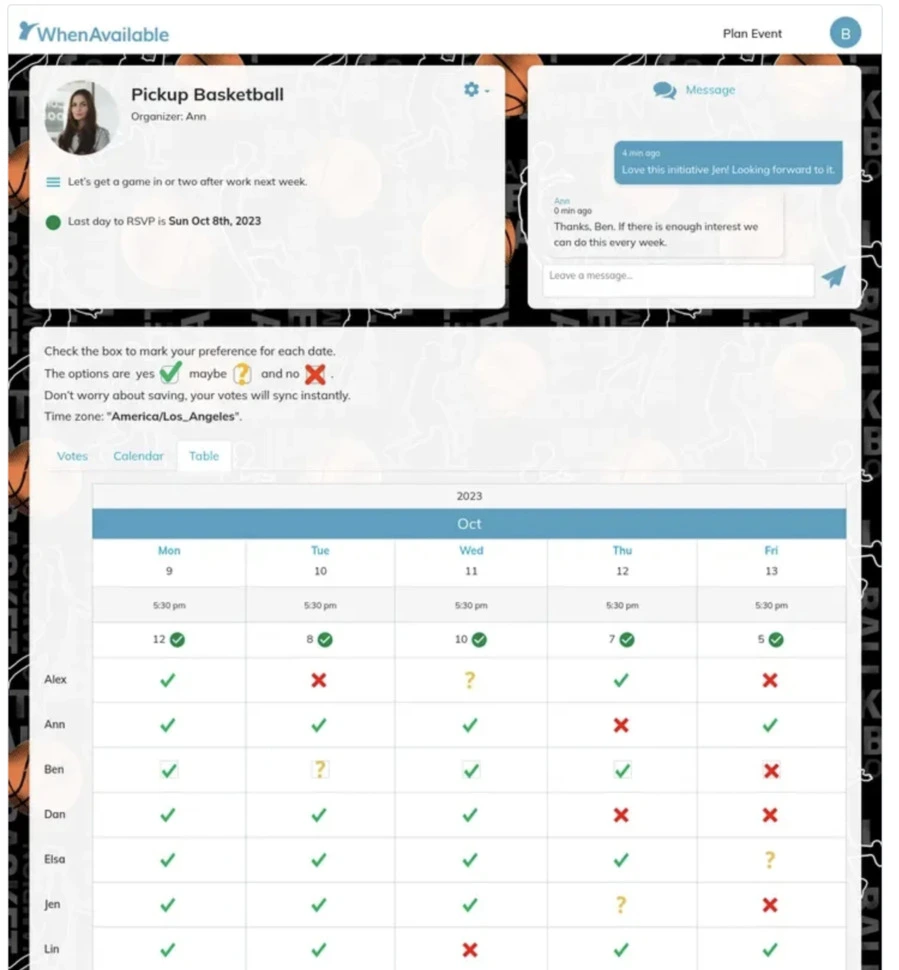
Image via WhenAvailable
Creating a poll is not only quick but highly effective, especially for larger teams or cross-departmental groups. It gives everyone a chance to have their say and ensures the meeting time works for the majority.
Polling eliminates guesswork and makes it easier to find a meeting time without unnecessary delays.
Polling fosters inclusivity and helps streamline the scheduling process. You get a better sense of when your team is truly available, which leads to more productive meetings.
Pro Tip: Use WhenAvailable to create unlimited polls for free.
6. Plan for Time Zone Differences
For teams spread across different regions, always consider time zones when suggesting meeting times. Adjust time zone differences, to ensure everyone is on the same page.
Scheduling across time zones can feel like juggling. Use tools like Time Zone Converter to pinpoint overlapping availability and find a meeting time that works globally.
Here’s a table comparing time options across global time zones:
| Time (Local) |
US (Eastern Time) |
Europe (Central European Time) |
UK (GMT) |
|
Option 1 |
9:00 AM |
3:00 PM |
2:00 PM |
|
Option 2 |
1:00 PM |
7:00 PM |
6:00 PM |
|
Option 3 |
4:00 PM |
10:00 PM |
9:00 PM |
A time zone converter can be invaluable when scheduling meetings across different regions. It allows you to quickly see what time it is in various locations, helping you find a meeting time that works for everyone.
Pro Tip: Rotate meeting times regularly so no one feels they never get their preferred times.
7. Analyze Past Meeting Data
To find a meeting time that works one of the most valuable resources at your disposal is past meeting data. If you’ve held similar meetings before, reviewing the attendance data from those meetings can offer important insights into how to find a meeting time that works for everyone on your team.
This can help you make more informed decisions about when to schedule future meetings, ensuring that you choose a time that maximizes attendance and engagement.
Here is an example of a Zoom attendance report:
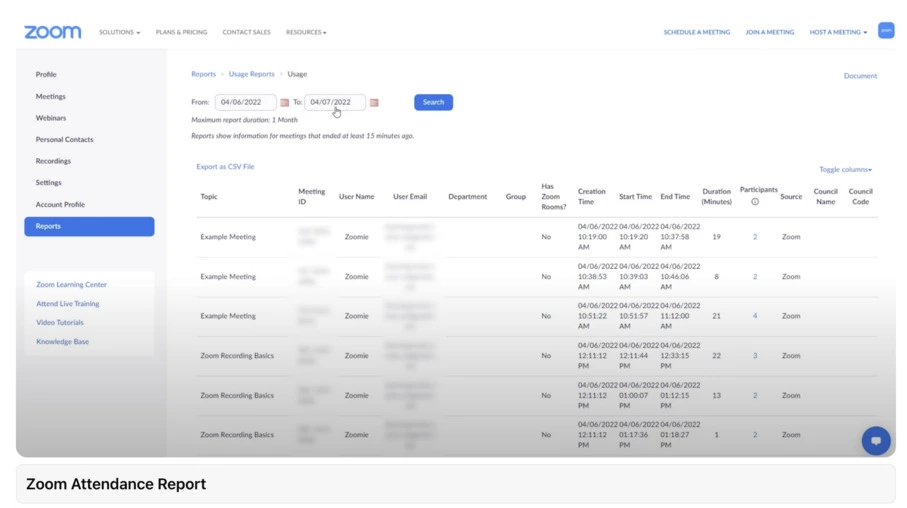
Image via Zoom
To get the most out of this data, track and store meeting attendance information in a centralized location. Over time, you’ll be able to build a history of successful meeting times that can guide your scheduling decisions.
Pro Tip: Use tools that automatically track meeting attendance and gather insights, helping you identify patterns and trends for more efficient scheduling in the future.
8. Communicate Meeting Details Clearly
Once you've learned how to find a time that works for everyone, you need to learn the importance of clear communication. It is essential to ensure smooth participation.
Here’s an example of a well-detailed meeting email invitation to discuss project timelines.
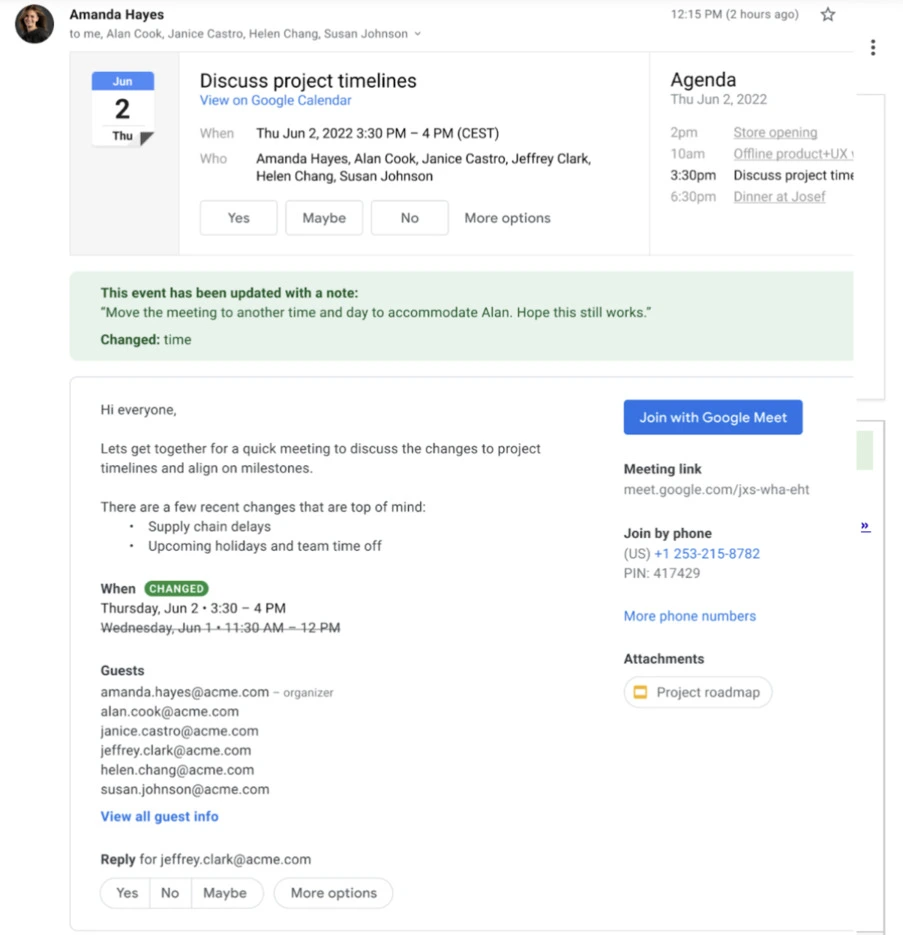
Image via Google Calendar
Providing all the necessary details, such as the meeting agenda, purpose, and organizer’s contact information, reduces confusion and keeps everyone on the same page.
Make it easy for participants by including a link to the virtual meeting platform, to ensure seamless access.
Pro Tip: Send reminders a day before the meeting to boost attendance and minimize no-shows.
Best Scheduling Tools to Consider in 2025
In this section, we’ll compare features of popular scheduling tools that can help you find a meeting time or schedule an event in 2025. If you’re tired of constant rescheduling, these tools can simplify the process.
Here’s a quick comparison of our top picks.
| Feature | WhenAvailable | Calendly | Microsoft Outlook | Google Calendar |
| Free Plan Available | ✅ Yes | ✅ Yes | ✅ Yes (with limitations) | ✅ Yes (basic features) |
| Automated Reminders | ✅ Yes | ✅ Yes | ✅ Yes | ✅ Yes |
| Time Zone Adjustments | ✅ Auto-detect time zones | ✅ Manual time zone selection | ✅ Auto-time zone adjustment | ✅ Auto-detect time zones |
| Recurring Meetings | ✅ Yes | ✅ Yes | ✅ Yes | ✅ Yes |
| Polls for Availability | ✅ Yes | ❌ No | ❌ No | ❌ No |
| Meeting Reminders | ✅ Yes (Customizable for each user) | ✅ Yes | ✅ Yes | ✅ Yes |
| Best for | Creating polls for availability and group scheduling | Simple scheduling for small teams | Teams integrated into the Microsoft ecosystem | Calendar sync and reminders |
These tools provide versatile options for how to find a meeting time that works for everyone, making collaboration easier and more efficient.
Also Read:
FAQ
-
What are some common challenges when scheduling meetings?
Some challenges include diverse schedules, time zone differences, last-minute changes (e.g., illness), and technology barriers, as not everyone may be familiar with digital tools.
-
How can I ensure maximum attendance at my meetings?
Learn how to find a meeting time that works for everyone to ensure maximum attendance. Offer multiple meeting time options and follow up via email or messaging platforms. This approach improves participation and makes it easier to find a meeting time that works for everyone.
-
Is there a tool specifically designed for group scheduling?
Yes! WhenAvailable is an excellent tool designed for creating polls to find suitable group schedules easily and effectively.
-
How do I handle last-minute changes in availability?
Keep communication channels open within your team. Encourage attendees to share conflicts openly so you can quickly adapt and find a meeting time that accommodates everyone.
-
What’s the best way to find a meeting time that works for everyone?
The best way to tackle how to find a meeting time that works for everyone is by using scheduling tools. These tools streamline the process by accommodating time zones, availability, and individual preferences, making group scheduling effortless and efficient.
Conclusion
Mastering how to find a meeting time that works for everyone is essential for small business owners looking to enhance productivity and collaboration in 2025.
By employing effective strategies and utilizing scheduling tools, you can easily find a meeting time that works for everyone involved without hassle or confusion.
Remember, the key lies in clear communication and flexibility as you strive to find a meeting time that accommodates all attendees’ needs while respecting individual schedules as well!
Ready to find a meeting time that works for everyone? Try WhenAvailable and take the first step toward easy scheduling today!
